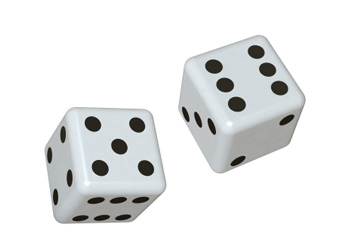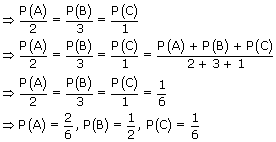
P(A ∪ B) = Probability of getting 5 on first die or 6 on second die.
Note that (5, 6) should be considered only once.
 =
=  .... (i)
.... (i)A = {(5, 1), (5, 2), (5, 3), (5, 4), (5, 5), (5, 6)}
 =
= 
B = {(1, 6), (2, 6), (3, 6), (4, 6), (5, 6), (6, 6)}
 =
= 
A ∩ B = {(5, 6)}

 +
+  –
–  =
=  .... (ii)
.... (ii) We see (i) and (ii) are equal.
If P(A ∪ B) = 0.65 and P(A ∩ B) = 0.15, find
ii) P(A) + P(B)
i) P(A ∪ B) = P(A) + P(B) – P(A ∩ B)
⇒ P(A) + P(B) = 0.80
We know P(A) = 1 – P(A) and P(B) = 1 – P(B)
P(A ∪ B) = 1 – P(A) + 1 – P(B) – P(A ∩ B)
| ⇒ P(A) + P(B) | = | 2 – P(A ∪ B) – (A ∩ B) |
| = | 2 – 0.65 – 0.15 | |
| = | 1.2 |
But how come the probability is greater than 1 ?
A number is chosen from the first 100 natural numbers. Find the probability that it is a number of 4 or 6
Given that one number is selected from first 100 natural numbers, n(S) = 100,
Here A = {4, 8, 12 . . . . ., 100}
Let B be the event of selecting a number which is multiple of 6;
⇒ n(B) = 16;
(A ⋂ B) is the event of selecting a number which is a multiple of 4 and 6 i.e., it is a multiple of 12.
⇒ n(A ⋂ B) = 8;
| P(A ⋃ B) | = | P(A) + P(B) – P(A ⋂ B) |
| = | 
|
|
| = | 
|
Three number are chosen at random from {1, 2, 3, . . . . , 10}. The probability that minimum of chosen number is 3 or maximum is 7, is
A → Minimum is 3, B → Maximum is 7,
| P(A ⋃ B) | = | P(A) + P(B) – P(A ⋂ B) |
| = | 
|
|
| = | 
|
A and B are seeking admission into IIT. If the probability for A to be selected is 0.5 and that of both to be selected is 0.3. Is it possible that, the probability of B to be selected is 0.9 ?
Given P(A) = 0.5; P(A ⋂ B) = 0.3
So, 0 ≤ P(A ⋃ B) ≤ 1
| P(A ⋃ B) | = | P(A) + P(B) – P(A ⋂ B) |
| ⇒ P(B) | = | P(A ⋃ B) – P(A) + P(A ⋂ B) |
| = | P(A ⋃ B) – 0.5 + 0.3 | |
| ≤ | 1 – 0.2 | |
| = | 0.8 |
If A, B, C are mutually exclusive and exhaustive event such that P(B) =  P(A) and P(C) =
P(A) and P(C) =  P(B)
Find odds in favour of (A ⋃ B)
P(B)
Find odds in favour of (A ⋃ B)
Since A, B, C are mutually exclusive and exhaustive
But given, 2P(B) = 3P(A) and P(B) = 3P(C)

 ; P(B) =
; P(B) =  ; P(C) =
; P(C) = 
Since A, B are exclusive,
 +
+  =
= 
Odds in favour of (A ⋃ B) are P(A ⋃ B) : P(A ⋃ B) = 5 ∶ 1
A is a set containing n elements. A subset P of A is chosen at random . The set A is reconstructed by replacing the elements of the subset of P, a subset Q of A is again chosen at random.
(i) P ⋂ Q = ϕ
(iii) P ⋃ Q = A and P ⋂ Q = ϕ
Let A = {a1, a2, a3, . . . . . , an}
(i) ak ∈ P and ak ∈ Q
(iii) ak ∉ P and ak ∈ Q
The total number of ways choosing the subset P and Q is 4n


